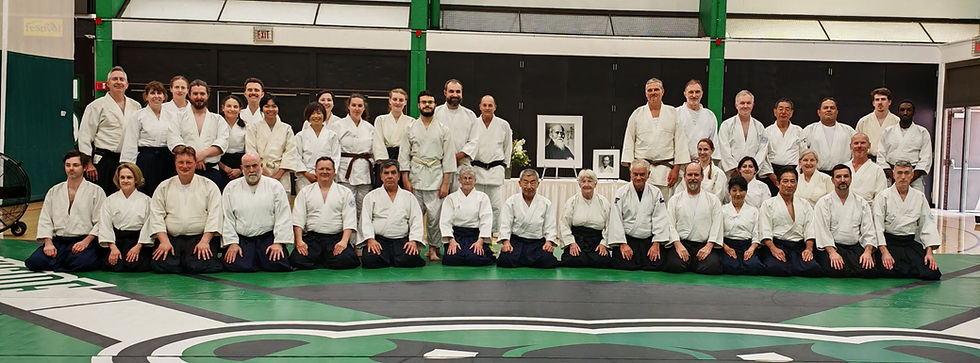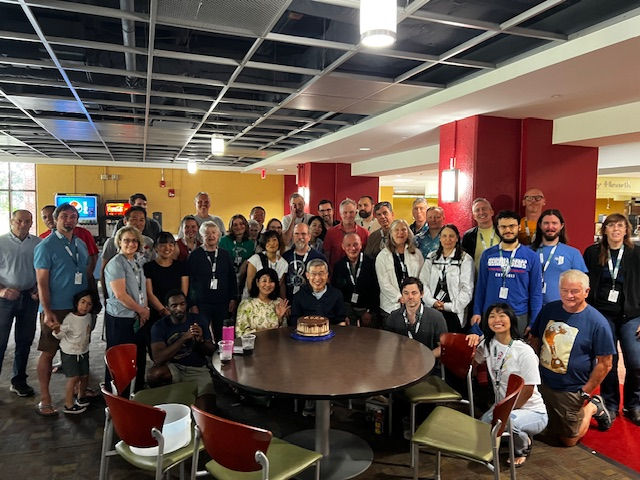MAF Summer Camp 2025 Experience
- 無刀会 合気道
- Jun 24
- 6 min read
Updated: Jun 25
Seki Shoji Shihan's seminars are held all over the world throughout the year, in France, Romania, Argentina, Brazil, Indonesia... Among these, the most special is the summer camp held every June in Kenosha, Wisconsin, USA, organized by MAF (Midwest Aikido Federation).
In Japanese, what we call a "Kosyukai(seminar)" is a group training session, but it’s common for each participant to arrange their own lodging and meals.
However, the MAF Summer Camp is different. It’s a complete "Gassyuku(training camp)"Training, lodging, and meals are all provided on one campus.
Participants eat, sleep, and train together, just like in their student days.
In Japan, it’s almost impossible for working adults to take a full week off for a Gasshuku—at best, they manage a weekend retreat lasting one night and two days.
That’s why the MAF Summer Camp is such a rare and special experience.

The summer camp was held at the University of Wisconsin-Parkside , a vast campus surrounded by forests about an hour's drive north of Chicago. We stayed in a university dormitory, ate three meals a day in the cafeteria, and practiced with Seki Shihan in the gym in the mornings and afternoons. It was like a short-term study abroad. It seemed as if my unfulfilled teenage dream of studying abroad had unexpectedly come true through Aikido. The participation fee of $675 included accommodation, meals, and training. Considering the current cost of living in the U.S., it was incredibly affordable. The airfare, however, was eye-wateringly expensive. Even so, the experience was more than worth it—it was truly irreplaceable.
We checked into the Pike River Suites student dormitory on the evening of Saturday, June 14th. Upon arrival, the organizer, Ms. Wentworth, and the MAF members welcomed us in the lobby. Ms. Wentworth is an intelligent and quiet woman with beautiful silver hair. There was no dinner on the night we checked in, but Kathleen, a veteran participant, took us to the supermarket by car. She has been participating in the camp since it began in 2001, and is a reliable presence who efficiently gives instructions to the young people and manages the situation.
The dorm rooms were simple but functional and comfortable. Each room was equipped with a bed, desk, and closet for one or two people, and the shower and toilet were shared between two or three rooms. The common areas were equipped with sofa sets, dining sets, microwaves, and refrigerators.
The laundry room had eight washing machines and eight dryers, which operated using a prepaid security card. After the morning practice, my uniform would be drenched in sweat, so having clean clothes for the afternoon session was essential. This setup was incredibly convenient and much appreciated.
Photos (clockwise from top left):
1. Student Dormitory (Pike River Suites)
2. Bed and desk in the room
3. Closet space
4. Shared living room
5. Dryer
6. Student center with cafeteria (UW-Parkside Student Center)
I ate at the cafeteria in the building next to the dormitory. To be honest, I didn't have high expectations for American food, but it was surprisingly healthy and satisfying. The main menu changed daily and was delicious, and the salad bar and fruit bar were well stocked at every meal. I never had to use the pre-cooked food I brought from Japan.
I was able to spend every day with a healthy bowel movement and no constipation.
They also have chocolate chip cookies for dessert, and a wide variety of drinks. They also have hot coffee and hot water. They have everything, except for alcohol, which you have to go to the supermarket to buy.
Photo (from left): Breakfast, lunch, dinner
Practices are held every day from Sunday to Friday, two in the morning and two in the afternoon. For me, who usually practices three to four times a week, six consecutive days of practice was an unknown world. It is possible to participate in only the first half or the second half, but when it is over, I think from the bottom of my heart, "I'm glad I participated for the full six days!"
For the first three days I had terrible jet lag, my body felt heavy and my sweat was sticky, but as the days went by my body adapted, and by the fifth day my sweat had turned into light, smooth sweat and I felt great.
During practice, they repeatedly repeated key points, such as "When attacking, you transfer the power of your stomach to your arms (= the point of contact with the opponent)" and "When defending, do not rely on grip strength, but move your feet to continue to pursue the point of contact," while changing their techniques.
Master Seki repeatedly communicated the sensation to me by making the sound of strength emanating from the stomach, “Nnggh!” I think the English translation would be “Gue!” (It’s easy to understand even if you don’t speak the same language!)
As I trained for hours every day until I was exhausted, the tension in my shoulders gradually relaxed and my senses changed. My body is in my mid-50s and is very stubborn, so in normal training I would start to get a new sense but by the next training session I would go back to the way I was, but after a week of intensive training, I felt like I had made it a habit. This must be the best part of a training camp.
Photos (from left)
1. Gymnasium (UW-Parkside Sports & Activity Center)
2. Gymnasium hallway
3. Dojo
Participants came not only from the Chicago area but also from as far away as Texas and Toronto, Canada.
Even white belts moved with their whole bodies to maintain connection throughout the techniques. I was especially struck by how some women took ukemi from strong male partners without hesitation. They were clearly experienced, which surprised me — I later learned that it takes 8 to 10 years to reach shodan here. In other words, even white belts often have many years of practice.
When I asked why they had started Aikido, many said they were drawn to the mysterious nature of the techniques. I heard that promotion exams are held only once a year, which made me wonder what keeps them so motivated. It made me want to learn more about their stories.
At large-scale seminars, it is easy for participants to come just to test their skills and ignore the themes presented by the sensei, making it difficult to practice.
In that respect, this camp was very easy to practice in because the theme of Seki Shihan was shared by everyone. This is probably because there were only about 40 people, so we could learn with the same people every day. I also think that the careful guidance by the MAF teachers on a regular basis played a large role.
Photos (clockwise from top left):
1. Schedule (Morning 8:30-9:30 will be taught by the participating dojo teacher)
2. Yachimoto Sensei of the Aikido Nobi Dojo
3. Same as above
4. Maeda Sensei of the Detroit Martial Arts School
After dinner, we enjoyed the "Ice Cream Social." There was a wide selection of ice cream and sweet toppings. It was a time for participants to deepen their connections with each other while enjoying the sweet temptations every night. On the second and fourth nights, there was also a Q&A session with Seki Shihan.
There were many technical questions, and Seki Shihan stood up and explained them to us with movements. It truly felt like a dream week—completely immersed in Aikido from morning till night.
Photo: From left
1. Ice Cream Social (In America, a social gathering over ice cream)
2. Sweets for toppings
3. Q&A with Seki Shihan
The participants were friendly even outside of practice. Several people spoke to me in Japanese. They said they watch sumo wrestling every time, or that they study Japanese by listening to Hoshino Gen's songs. I'm glad they are interested in Japanese culture other than Aikido. I can manage with my broken English, but next time I'll study English conversation so I can speak a little more.
The MAF members were really attentive and hardworking, going into the gym first thing in the morning to prepare hydration drinks, disinfecting the mats twice a day, once in the morning and once in the afternoon, and preparing ice cream and snacks in the evening.
I was deeply moved when I saw that the flowers next to the photo of O-Sensei Morihei Ueshiba had been changed midway through the camp. This kind of thoughtfulness helps create a comfortable atmosphere at the camp.
Photos (from left)
1. MAF members wiping down the mats
2. Photos of O-Sensei Morihei Ueshiba and Akira Tohei Sensei and white flowers
3. By Wednesday, the flowers had been replaced with blue and purple ones.
This camp has been held since 2001. The warm atmosphere that exists today is surely the result of the trust that has been built up between Seki Shihan and the local people over the past 25 years.
This special space has been built up over a long period of time and is truly a treasure.
The dates for next year's summer camp have already been decided. It will be from June 14th to June 19th (check-in is June 13th). I'd love to go again next year!

Hitomi Akiyama














































Comments